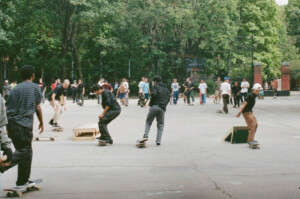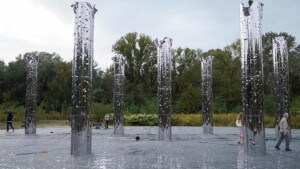This article appears in The Architect’s Newspaper’s April 2017 issue, which takes a deep dive into Florida to coincide with the upcoming AIA Conference on Architecture in Orlando (April 27 to 29). We’re publishing the issue online as the Conference approaches—click here to see the latest articles to be uploaded.
The Bro Bowl—an erstwhile icon of Tampa’s skateboarding scene—reopened last year with its spirit transposed to a graffiti-free imitation just a few hundred feet from its original footprint. While the skate park initially strained relations between the area’s skateboarders and the African American community—both made full-throated claims to the site—it seems that the new design has assuaged both sides.
Planner Joel Jackson, a City of Tampa employee who seized on what was then a sub-cultural sport, was inspired by the informal use of swimming pools and designed the Bro Bowl in the mid-seventies. Built in 1978 as part of the Perry Harvey, Sr. Park, the Bro Bowl was among the first skate parks in the country. For the activists involved with brobowl.org, the demolition of the landmark in 2015 marked the loss of a cultural and social memory, especially considering that the move effectively revoked its historic status. Other activists claim that the site was significant not simply as a nostalgic moment in history, but as a public commons essential to resisting the commercialization of private skate parks.
For some, however the removal of the Bro Bowl was a necessary part of a larger city-led effort to transform the Scrub neighborhood and Central Avenue drag. Many community leaders saw the redevelopment initiative as a method of reclaiming a bygone history of the African American experience in Tampa. The neighborhood has been occupied by African American families as far back as the Civil War, and has seen a growth of African American–owned businesses throughout the years. But under the auspices of urban renewal, some claim that much of this community was decentralized and even permanently lost. The redesign of Perry Harvey, Sr. Park and the investment in residential and commercial projects nearby was an attempt to realign the residents with the heart of their community.
Tension between the two stakeholder groups has largely subsided in the wake of the park’s overwhelming success. The site of the former Bowl was replaced with a series of display apparatuses with imagery and text detailing prominent members of the African American community, both locally and nationally, as a kind of urban storytelling. Though the Bowl lacks the material history that was so beloved by the skateboarding world, small parts of the extant concrete surface remain in situ. The new skatepark was designed using laser-imaging technology to recreate the feel of the previous concrete surface. According to the Tampa Bay Times, local skateboarders are impressed by the similarities between the original and the replica, “They almost nailed it,” Brian Schaefer, Skatepark of Tampa founder, told the Times.










